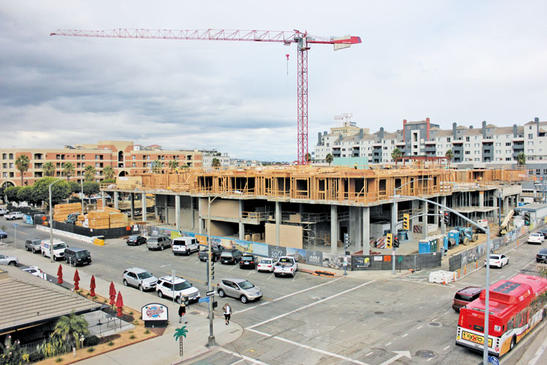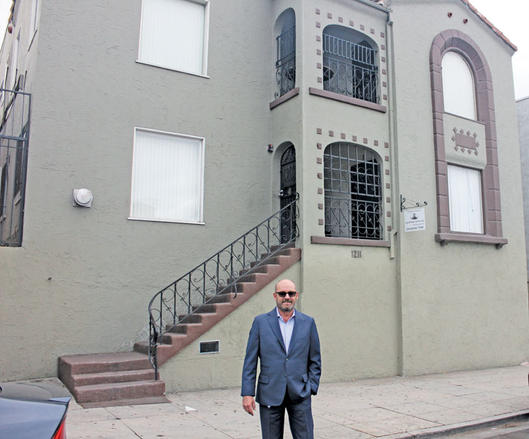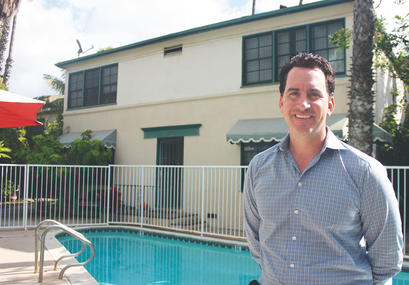Long Beach Home Prices Surpass 2007 Peak
It’s “boring but true”: the same market dynamics of low supply and high demand that have been driving up sales prices of Long Beach single-family homes for the past few years continue to hold, according to California Association of Realtors President Geoff McIntosh.
Given current demand, all single-family homes listed on the market in Long Beach would sell out within 2.4 months, and all condos would sell within 2.1 months, McIntosh said. “The average number of days on market from list to sell was 29 days. And the average price of a single-family home [in September] in Long Beach was $620,000,” McIntosh said.

Construction crews have reached the third story of the seven-story Park Broadway development on the northeast corner of Broadway and Cedar Avenue. Directly to the north of the project is Sares-Regis Group’s 3rd & Pacific, a 163-unit multifamily residential development that is under construction. (Photograph by the Business Journal’s Brandon Richardson)
Phil Jones, owner of Coldwell Banker Coastal Alliance and a boardmember of both the state and national associations of Realtors, said the median price of single-family homes in Long Beach is “as high as it has been in my memory.”
During the same month, the median price of Long Beach condos was $410,000, according to McIntosh, who is also the owner of Long Beach-based Main Street Realtors. “That is up 30% from a year ago. But that is an indicator to me that there is no entry-level condo inventory available, so the stuff that is selling is the upper-end stuff,” he noted.
Mary Whirledge, Realtor with Coldwell Banker Star Realty, pointed out that figures from both the S&P/Case Schiller Index and Home Price Index by CoreLogic illustrate that the single-family price peak of 2007 was surpassed in May of this year. “Prices are up, supply is down and buyer demand is high,” she said.
The number of new single-family listings in September decreased in comparison to the same month in 2016 by about 14%, and the number of new condo listings decreased by 27%, according to Jones. “There are only 635 properties available at the end of September on the Multiple Listing Service. And historically we have seen as many as 2,500 to 3,000 properties available,” he said.
McIntosh pointed out that homeowners are staying in their homes longer than was common in prior years. “I came upon a statistic that 74% of people 55 and older have not moved since the year 2000, which means that people are staying in their homes much longer,” he said.
“We used to anticipate houses turning every four to five years, and on a statewide basis it’s well over 10 years now. And in coastal California, like Long Beach, it’s closer to 19 years.”
Despite increasing home prices, demand to buy is “still incredibly high,” particularly for entry-level priced properties, McIntosh noted. “In entry-level properties, we can almost count the time on market in hours instead of days. It’s that bad,” he said. “Now when you move into higher-end inventory . . . of say $1.5 million up, we have a much more normal inventory: probably between six and eight months of inventory in that upper-end property.”
Whirledge said that she does not believe the current single-family market in Long Beach is a “bubble.” “Unlike the 2007 market where many buyers were over-leveraged, there are new lending regulation requirements that for the most part prevent that environment – hopefully leading to future market strength,” she said.
Both McIntosh and Jones are concerned about tax proposals from the GOP and Trump administration. It has been widely reported that the state and local tax (SALT) deductions and property tax deductions would be eliminated in the House of Representative’s tax bill, which has not been released yet. Both McIntosh and Jones believe this would be detrimental to California homeowners.
“In California, we’re really being hit hard if the [tax] plan goes through as proposed,” Jones said. “As it’s proposed right now, they are eliminating the ability to deduct your property taxes, your state taxes, and your local taxes. In other words, it becomes double taxation. So we’re opposing it on that premise for sure,” he said.
“For a homeowner who makes $100,000 a year – which is what’s required approximately to buy a median priced home – under current tax law their tax liability would be $9,340. And under proposed law, it would be $10,478,” McIntosh said. “And the more they make, the more it goes up.”
McIntosh noted that homeowners of all income levels would likely be impacted by a proposal to double the standard deduction because it would eliminate the benefit of using the mortgage interest deduction. Those taking the standard deduction cannot use itemized deductions. “About 70% of properties in California have a mortgage,” he said. “It would probably cause our [sales] volume to drop 2.5% or 3%, because people would analyze it and [say], well, there is really not much benefit for me in owning now,” he speculated.
Both the state and national associations of Realtors are lobbying elected officials in Washington, D.C., to address these concerns.
Long Beach Multi-Family Market May Be Topping Out, Experts Say
In the past few years, attractively low interest rates, strong demand and a short supply of Long Beach multi-family properties have created an environment in which price points and rental rates have experienced significant gains. Now local real estate professionals specializing in apartment buildings believe the price appreciation for some, if not all, of these properties may be topping out.
“Pricing right now is like a razor’s edge. If you miss price by a little bit over the market, it could sit for a while,” Steve “Bogie” Bogoyevac, senior vice president of investments for the Long Beach office of Marcus & Millichap, told the Business Journal. “I think we have kind of topped out a bit.”

Steve “Bogie” Bogoyevac, senior vice president of investments with the Long Beach office of Marcus & Millichap, just sold this 16-unit building at 1211 Magnolia Ave. north of Downtown Long Beach. The asking price was $2.5 million. (Photograph by the Business Journal’s Brandon Richardson)
Eric Christopher, senior associate with INCO Commercial, also said that pricing for multi-family buildings in Long Beach seems to be reaching a plateau. “I don’t see windfall appreciation happening going forward because the prices have reached a point where the lending parameters are being maxed out,” he said. “We used to be able to sell a building for 25% down. And based on the pricing going where it has, the down payments have increased to 35% to 40% to meet the debt parameters that are required.”
Still, there is room for rental rates to increase, which would add to the value of properties, Christopher noted. “That will organically keep the price going up based on the [rental] income stream. But just from a pure market appreciation, which is [like] the tide, if you will, I think the tide has probably hit the high tide level.”
Robert Stepp, principal of Stepp Commercial, believes that high-quality Class A buildings and good quality Class B buildings with amenities should continue to experience price gains. “We think the A area is going to get even more expensive. We’re seeing some record prices on properties on either the sand or in Belmont Heights/Belmont Shore,” he said.
Mike Toveg, senior vice president of Stepp Commercial, noted that Class C properties, which are of lesser quality, have likely topped out in price. “People are a little more cautious than usual, just because the market is so high,” he said of potential buyers. “For [Class] A and B markets, I think those investors and buyers are willing to stretch a little more than they will on a [Class] C asset.”
All three noted that sales of multi-family properties continue to be strong, with many deals occurring off-market. “There have been more off-market deals now than we have ever seen in my 14 years [in real estate],” Stepp said. “That is the biggest change we have seen this year in how properties are sold: the fact that they are sold off-market. A seller gets a call from an agent who has got an offer, he likes the offer, and they just accept it. It’s that quick.” Stepp said he would prefer sellers consult with a broker and list their property in order to get the best value.

Robert Stepp, principal of Stepp Commercial, is pictured at a 26-unit property listed by his company for $8.4 million on Livingston Drive in Belmont Shore. Stepp said that many owners of apartment buildings are accepting off-market proposals, which he does not recommend in order to get the best price. (Photograph by the Business Journal’s Brandon Richardson)
“There is heavy transaction volume,” Bogoyevac said. “By the end of the year I will have closed at least 88 deals. And usually a really great year for me would be about 45 deals.”
Bogoyevac said he expects current market dynamics to continue, barring any major shift in interest rates or the economy, or a global event such as a conflict with North Korea. “We are still seeing lots of development happening, which I think bodes that the economy is doing well,” he said. “Developers see a future.”
Christopher noted that outside area investors are not as likely to view Long Beach’s multi-family prices as high, considering that surrounding beach communities are more expensive.“We still have so much importation of capital coming from like West L.A. and the outlying areas where there is an accumulation of wealth. Long Beach is now really sort of on everybody’s radar. There is a massive influx of capital,” he said.
